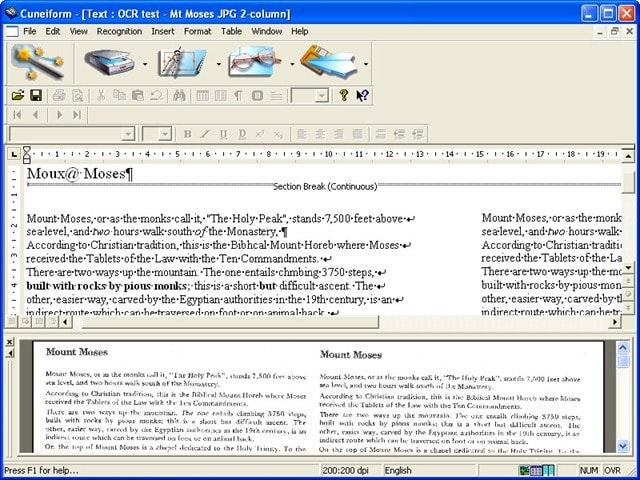Ocr Cuneiform
Posted : admin On 14.10.20191.1 / April 19, 2011 ( 2011-04-19) Written in and / Website CuneiForm is a software tool for. It was originally developed at Cognitive Technologies and, after a few years with no development, released as on December 12, 2007. The kernel of the OCR engine was released under the license at the beginning of April 2008. Features used in CuneiForm come from the rules for writing, from their topology, and do not require pattern recognition learning. CuneiForm recognizes any print font ( from, printer output, output, text, etc.). It does not recognize handwritten or pseudo-handwritten text nor does it recognize decorative fonts (e.g.

There are special settings in CuneiForm for recognition of text from and 200x100 resolution faxes. CuneiForm can save text formatting, and also recognizes complicated tables (of any structure). It recognizes, Russian-English bilingual, and text.
This article will introduce you the 3 best open source OCR programs and teach you how to OCR. Cuneiform was converted to open source by its developer when further. OCR programs will convert non editable text (scanned images, PDF) into editable document (use Word, Notepad). If you have an image with text and you need to use text.
Os Cuneiform
CuneiForm can save recognized text in, or format. It can also pass text to.

User interface CuneiForm can be used as a stand-alone application, or as a to other programs. It comes with its own. CuneiForm can be also used as an OCR engine in.
History Once a leader of OCR software in, CuneiForm was in competition with. In 1993, Cognitive Technologies signed an contract with, which allowed the Cognitive recognition library to be built into the popular publishing package (and subsequent versions). In 1996, OCR CuneiForm'96 was released, which was the first OCR package to include the adaptive recognition method of character recognition. This method is based on a combination of two types of printed characters recognition algorithms: multifont and omnifont. This self-learning system is capable of recognizing poorly printed symbols by creating an internal font generated by those symbols which were printed well enough to be recognized.
Ocr Cuneiform 12
Thus dynamic adjustment (adaptation) for specific input characters is used. In June, 2008 Cognitive Technologies launched a free recognition service on. Opening sources Cognitive Technologies has started a program to make available for all users. Its first step was releasing CuneiForm as.

Cognitive Technologies plans to start developing a new version of the software as an investor and coordinator of the project. Developers decided on the for the release to take into account all legal and technical nuances, but the whole program or its separate modules may be released later licensed under the. In September 2008, part of Cuneiform was released as open source software. One of the missing parts is table analysis, However, Cognitive has promised to release this component in the future. Cuneiform is being ported to, and.
This branch of code will finally be merged with Cognitive codebase.
Wiki Cuneiform
OCR programs will convert non editable text (scanned images, PDF) into editable document (use Word, Notepad). If you have an image with text and you need to use text from that image or to modify it, you need to use an OCR software (optical character recognition).
Cognitive OpenOCR (Cuneiform) can be used to convert automatically text from images or scanned files into editable documents (Word). Can be integrated with your scanner, and for example, if you have an invoice or a book, you can scan it then OpenOCR will receive pages to transform them in editable word files. You can work with files from local hard drive or files imported directly from scanner. It will recognize letters from different languages, is able to make spell checking after conversion, you can opt in to check or not to search tables or pictures from source file. After is making conversion, can leave result for further editing or save as document file.